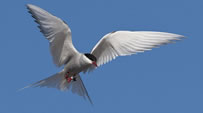Saturday, January 23, 2010
Longest Animal Migration - The Arctic Tern
sets world record
GREENLAND, Denmark --An international research
team from Greenland, Denmark, the United States, Great Britain,
and Iceland ( Study leader Carsten Egevang
, from the Greenland
Institute of Natural Resources
) found that the Arctic
tern, flies more than 44,000 miles (71,000km) from pole to
pole each year, flying between its breeding grounds in Greenland
and the Weddell Sea on the shores of Antarctica -setting the
world record for the Longest
Animal Migration
. 
Photo: Arctic Tern with a geolocator
tracking device attached to its leg. The bird was tracked
on its world's
Longest Animal Migration
.
( enlarge
photo
)
Scientists made the discovery after
attaching tiny tracking devices to terns to map their mammoth
migrations.
The device regularly records light intensity,
which can be used to generate two geographical positions per
day. While geolocators have helped scientists follow the journeys
of larger animals, including geese, albatross, penguins and
seals, they have only recently been made small enough to attach
to lightweight birds, such as the tern. The researchers fitted
geolocators weighing about 1.4 grams each to the legs of 60
terns.
They found that the birds do not immediately
travel south from Greenland, but first spend almost a month
at sea in the middle of the North Atlantic ocean.
They then continued down the coast of north-west
Africa. Around the Cape Verde Islands the researchers were
surprised to find that about half the birds carried on south
along the African coast while the rest crossed the Atlantic
to follow a parallel route down the east coast of South America. 
Photo: Migration patterns of the Arctic
tern, from the breeding sites in Greenland and Iceland to
the winter grounds at Antarctica. The birds take a month-long
break in the Northern Atlantic to refuel ( enlarge
photo
)
All the terns studied escaped the northern
winter by flying to Antarctic waters, where it is summer at
the same time of year. But they did not choose the shortest
route back to Greenland.
Instead, they traced a giant 'S' pattern
northward through the Atlantic Ocean, making a detour of several
thousand miles.
The diversion took advantage of prevailing global
wind systems to help the birds preserve energy.
The findings are published in the journal Proceedings
of the National Academy of Sciences
. Study leader Carsten Egevang
, from the Greenland
Institute of Natural Resources
, said: "This study
on seabird migration has given us an incredibly detailed insight
into how long-distance migrants behave at times of the year
when it's normally impossible for us to follow them.
"Our analysis shows that the birds' behaviour
is closely correlated with both biological and physical parameters
along the migration route. They paused in their southward
migration to spend time in highly productive waters in the
middle of the Atlantic Ocean. Compared to this stop-over site,
the marine area immediately to the south is lower in productivity.
Clearly, Arctic terns have learned to 'fuel up' before crossing
areas of ocean with limited foraging options."
Arctic terns can live up to 34 years. When
the scientists added up the total distance each bird flew
during its lifetime they found it equalled three round trips
to the Moon - or more than 1.25 million miles.
"This is a mind-boggling achievement for a bird
of just over 100 grams," said Mr Egevang.
The previous Guinness world record for the Longest
Animal Migration
was set by the sooty shearwater,
a seabird that makes a 40,000-mile circular trek each year
from New Zealand to Alaska.
Related world records
:
Nature
world records
Largest
genetically engineered trout - world record set by Sean Konrad
Oldest
Living Palmer's Oak- Jurupa Oak sets world record
Smartest
dog - world record set by Betsy
Tallest
Zinnia - world record set by Everett Wallace Jr.
and
Melody Wagner
Saturday,
January 23, 2010
